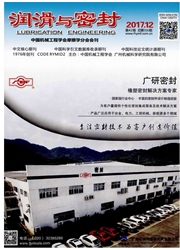

 中文摘要:
中文摘要:
考虑液膜空化的影响,采用有限单元法求解层流、等温条件下控制流体密封端面膜压的雷诺方程,分析大圆形孔端面机械密封在不同端面几何结构参数和操作条件下,端面液膜压力分布以及开启力、液膜刚度和泄漏率等密封性能参数的变化规律,对比微孔与大孔密封端面的性能,指出大圆形孔端面密封产生承载力的机制;以最大液膜刚度及开启力为优化目标,在研究范围内获得大孔的最佳孔深。结果表明:在相同研究条件下,随着孔径和孔数的增加,大圆形孔产生的流体动压效应比微孔更强;随着介质压力的增加,静压效应增强,空化效应减弱,由此导致端面开启力增大,液膜刚度下降,泄漏率增大;随着转速的增大,开启力和液膜刚度均增大,而泄漏率减小。
 英文摘要:
英文摘要:
When the cavitation of liquid film was considered, finite element method was used to resolve Reynolds equation for the liquid film pressure between two faces of a mechanical seal for a laminar, isothermal fluid. Opening force, leak- age rate and film stiffness of mechanical seals with macro-pores were analyzed, when various geometric conditions and oper- ating parameters were given. The mechanism of load capacity was pointed out in a face seal with macro-pores. The results show that macro-pores produce better dynamic pressure effect than micro-pores and the best depth hole is obtained when taking maximum film stiffness and opening force as optimized goals in the range of study, as the aperture and pore number increase. When pressure is increasing, cavitation effect is weakened and static pressure effect is enhanced, leading to the enlargement of opening force and leakage rate, and the decrease of film stiffness. Along with the enlargement of speed, opening force and film stiffness will enlarge, while leakage rate will reduce.
 同期刊论文项目
同期刊论文项目
 同项目期刊论文
同项目期刊论文
 期刊信息
期刊信息
